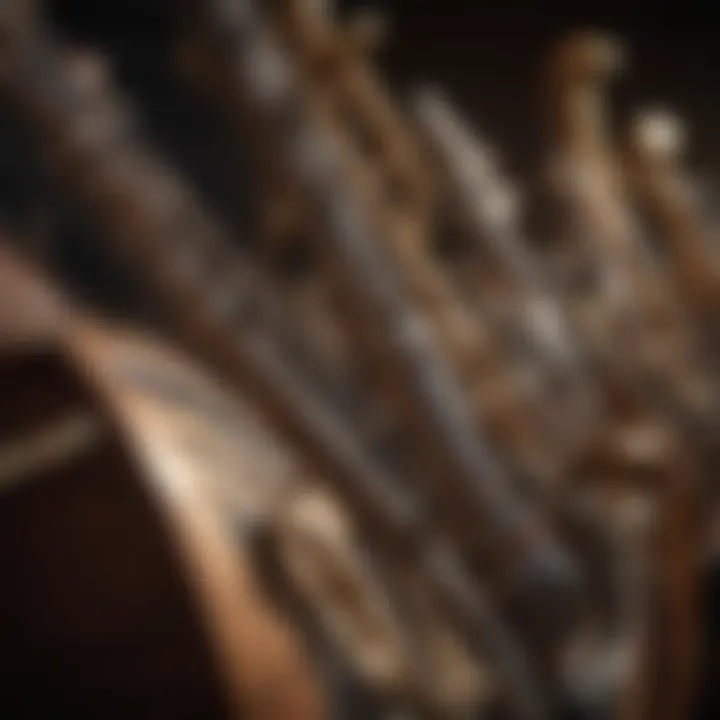In-Depth Exploration of Music: Insights and Analyses


Intro
Music acts as a universal language, connecting people from various backgrounds. Its ability to evoke emotions and transmit cultural narratives is unmatched. This exploration focuses on crucial elements of music, such as artists, genres, and themes; it delves into its evolution while highlighting contemporary impacts. The aim is to enlighten music enthusiasts and aspiring musicians, providing them with a richer appreciation of music's significance today.
Artist Profile
Biography and Background
Understanding an artist's journey provides insights into their work. An artist's life often shapes their music, making biography an important aspect of music analysis. Many notable musicians have faced struggles, joys, and influences that substantially alter their artistic expression. For instance, consider the life of Joni Mitchell. Born in Canada in 1943, she began her career as a folk artist and evolved to incorporate rock and jazz elements. Her childhood illness, polio, and early experiences in art and music were fundamental in shaping her unique sound.
Major Influences and Inspirations
An artist’s influences can range from personal experiences to cultural currents. Joni Mitchell drew inspiration from various sources, including folk traditions and jazz legends. She frequently collaborated with others, creating sounds that reflect her experiences and the society around her. Artists like Bob Dylan and Leonard Cohen have also notably impacted her work, adding layers to her songwriting craft. Understanding these influences is vital as they often inform the context in which an artist operates.
Song Analysis
Theme and Lyrics Breakdown
Analyzing a song reveals how lyrics convey themes and messages. Take Joni Mitchell's "Both Sides, Now" as an example. The song represents perspectives on life, love, and loss. The lyrics reflect maturity and introspection, showcasing how personal insights can crystallize universal truths. By dissecting lyrical content, listeners gain deeper awareness of prevailing themes.
Instrumentation and Composition
Instrumentation plays a crucial role in establishing a song's atmosphere. In "Both Sides, Now," the orchestration consists of strings that enhance emotional resonance. The simple chord progressions combined with Mitchell's insightful lyrics create a poignant listening experience. This relationship between melody and lyrical meaning signifies the importance of composition in music.
"Songs are a reflection of life, filled with feelings that resonate across time and culture."
Ending
Through exploring artists and their songs, we can uncover the intricate layers within music. Each element—be it biography, influences, themes, or composition—contributes to a deeper understanding of this art form. By engaging on this level, we not only appreciate music for its entertainment value but also for its profound impact on society and culture.
Understanding the Essence of Music
Music plays a fundamental role in human society. It acts as a mirror of culture, reflecting shared experiences and emotions. In this exploration, we aim to dissect the layers of music as an art form, providing insights that are both valuable and enriching for enthusiasts, musicians, and scholars alike. By breaking down music into its many components, we seek to deepen understanding and appreciation of this timeless medium.
Defining Music
To begin, let’s define what music is. Music can be described as organized sound that evokes emotions and ideas. It combines various elements, including melody, harmony, rhythm, and timbre. These components work together to create a structure that can be understood and appreciated by listeners.
Music transcends mere audio; it is an experience that resonates within individuals. Every culture around the world has its interpretation of music, leading to diverse forms and styles. For instance, Western music often emphasizes harmony, while many African and Asian traditions focus on rhythm.
"Music is an outburst of the soul." – Frederick Delius
This quotation encapsulates music’s ability to express deep-seated emotions. Whether it evokes joy, sorrow, pain, or elation, music creates a connection across boundaries.
Cultural Context and Music
Examining music requires understanding its cultural context. Music is not created in isolation; it is influenced by the environment, history, and social dynamics of a particular group. Each musical tradition is a product of its time and circumstance. For instance, the blues genre emerged from the African American experience, rooted in the struggles of oppression and the quest for freedom.
Traditional music can tell stories about a community’s past, beliefs, and values. In contrast, contemporary music often reflects current societal issues. Today, genres frequently blend, showing the fluidity of cultural influences in music. Genres such as hip-hop, pop, and reggae often draw on elements from various traditions, highlighting how interconnected music can be.
Understanding this context is crucial for music enthusiasts and aspiring musicians. It enables them to appreciate not just the art itself, but also the history and emotions that inform it. By recognizing music's cultural significance, individuals gain a more profound respect for artists and the messages conveyed through their work.
The Evolution of Music Genres
The evolution of music genres showcases the dynamism and adaptability of music as an art form. Understanding how genres have changed over time is important for several reasons. It helps anyone interested in music to appreciate the influences that shaped today's sounds. It also highlights the cultural, social, and technological shifts that have impacted musical styles. This section will provide a detailed exploration of the historical context of music genres and current trends in genre fusion.
Historical Overview
The historical overview of music genres reveals the roots of various styles and their cultural significance. Early music primarily stemmed from oral traditions, rooted in different societies. As these societies evolved, so did their musical expressions. For instance, classical music emerged in Western Europe during the Middle Ages, characterized by its structured form and intricate compositions. This genre laid the groundwork for many contemporary styles.
During the 20th century, genres experienced a significant transformation. The rise of jazz in the 1920s signaled a shift toward improvisation and individual expression. In the subsequent decades, rock and roll emerged, influencing countless artists and evolving into sub-genres like punk and metal. Each decade brought new influences and innovations, such as the emergence of hip-hop in the 1970s, which utilized sampling and rhythm patterns that reshaped popular music.
"The journey of music genres is not just about sounds; it's a reflection of history and culture."
Understanding these historical developments enables listeners to grasp the diverse influences in contemporary music. Genres do not exist in isolation; they borrow elements from one another, continually evolving and adapting.
Contemporary Genre Fusion
Contemporary genre fusion has become a hallmark of modern music. Today's artists often blend elements from multiple styles to create something wholly new. This hybridity reflects contemporary society's diverse cultural landscape.
Several factors contribute to this trend. The advent of digital technology has made it easier for artists to experiment, producing music that fuses genres like pop and electronic, or country and hip-hop. For instance, artists such as Billie Eilish have combined pop with alternative and electronic sounds, attracting a wide audience and challenging genre boundaries.


Moreover, the influence of global music has also played a role. Artists like Bad Bunny have popularized Latin trap, merging traditional Latin sounds with hip-hop and reggaeton. This crossover not only broadens audiences but also fosters a sense of cultural exchange in music.
The rise of streaming platforms enhances accessibility to various genres. Listeners can explore a wider range of music than ever before, encouraging them to appreciate the rich tapestry of sounds available. As a result, the lines between genres continue to blur, and new forms can arise unexpectedly.
Iconic Artists Who Shaped Music History
The journey through the sonic landscape of music is, in large part, defined by the artists who have left an indelible mark on its history. Their contributions not only reflect personal talents but also embody the cultural and societal shifts that occur over time. This section will explore Iconic Artists Who Shaped Music History, detailing their significance across various music genres, their lasting influence, and the lessons they impart to contemporary musicians and enthusiasts alike.
The Contributions of Legendary Figures
Legendary figures in music often transcend their time, becoming symbols of change or expression. Artists like Ludwig van Beethoven revolutionized classical music, introducing elements of emotion and complexity previously absent. His symphonies are studied not only for their musical depth but for their historical context, representing the human struggle and triumph during the late 18th and early 19th centuries.
Similarly, figures such as Ella Fitzgerald showcased the power of jazz through their vocal techniques and improvisation skills. Fitzgerald’s ability to interpret lyrics and improvise melodies helped to define the jazz genre, influencing countless artists who followed.
These musicians, amongst others, have set a benchmark in artistry. Their work encourages current and upcoming artists to explore emotions through their music. Key contributions include:
- Innovative Techniques: Introducing new styles that reshape genres.
- Cultural Resonance: Creating music that echoes the sentiments of their time.
- Legacy of Skills: Passing down techniques that inspire future generations.
Influential Modern Artists
The landscape of modern music is equally rich with artists who continue to shape the soundscape. Names like Beyoncé and Kendrick Lamar are significant examples. Beyoncé’s fusion of R&B, pop, and hip-hop demonstrates modern versatility, while her lyrical themes often address identity, empowerment, and societal issues. She has become a voice for many, using her platform to advocate for change.
Kendrick Lamar’s work, particularly in albums like To Pimp a Butterfly, illustrates the intersection of music and cultural commentary. He explores themes of race, trauma, and personal development, pushing the boundaries of hip-hop beyond mere entertainment. His storytelling technique captivates listeners and encourages introspection.
- Diversity of Message: Modern artists often use their platform for social issues.
- Genre Blending: Many contemporary musicians blend different genres, creating unique styles.
These artists not only entertain but also prompt discussions on important societal topics. Their contributions exemplify how music evolves as a reflection of its environment, redefining what it means to be an artist in the contemporary era.
Ultimately, the impact of iconic artists, both past and present, plays a critical role in shaping musical history. They demonstrate how music can transcend barriers, creating a shared experience that resonates with diverse audiences across generations.
Analyzing the Impact of Songs
The impact of songs on individuals and society is profound. Music has an ability to evoke emotions, provoke thoughts, and facilitate connections among people. In this section, we explore how songs can shape cultural identities, influence social movements, and resonate on a personal level. Understanding song impact enriches appreciation for this art form, highlighting its significance not merely as entertainment but as a catalyst for change and reflection.
Lyric Interpretation
Lyrics serve as the voice of a song, conveying messages that can range from the mundane to the profound. These words create narratives and evoke feelings, often reflecting society’s zeitgeist. The interpretation of lyrics is subjective. Different listeners might derive various meanings based on their own experiences and context.
Analysing lyrics allows for deeper engagement. For instance, consider a song like "Imagine" by John Lennon. Its simple yet profound lyrics promote peace and unity. An enthusiast might interpret this as a call for hope amidst societal conflict. This personal interpretation fosters a more substantial connection, encouraging listeners to reflect on their beliefs and the world around them.
Key points for lyric interpretation:
- Cultural Context: Understanding the era and situation when a song was written can offer insight.
- Emotional Resonance: Identifying personal feelings invoked by the lyrics can lead to deeper meaning.
- Ambiguity: Recognizing that some lyrics are intentionally vague allows for a broader range of interpretations.
Melodic Structures
Melody is the backbone of a song. It is often the first element heard and sticks in the listener's mind. Melodic structures significantly influence how a song is perceived. For example, a catchy melodic line can drive a song's popularity, while intricate melodies may appeal to more discerning listeners.
Analyzing melodic structures can uncover the compositional skills used by artists. Repetition, motifs, and key changes contribute to how listeners engage with a piece. For instance, the repetition of a catchy hook can make a song memorable, while varied melodies can create emotional depth.
Consider these elements in melodic analysis:
- Motif Development: How a theme evolves throughout a song can enhance its narrative.
- Harmony: Chords complement the melody, often shaping the listener's emotional response.
- Rhythmic Variation: Changes in rhythm can energize a song and engage listeners.
The combination of lyrics and melody creates a complex layer of meaning within a song, emphasizing its ability to impact deeply on personal and societal levels.
The Role of Technology in Music Production
The integration of technology in music production has reshaped how music is created, distributed, and consumed. This discussion centers on two critical aspects: digital recording techniques and the proliferation of streaming platforms. Understanding these elements not only highlights their importance in contemporary music but also emphasizes their broader impact on the music industry, making them essential for any music enthusiast, aspiring musician, or student.
Digital Recording Techniques
Digital recording techniques have revolutionized the music creation process. With advancements in software and hardware, artists and producers are now equipped with tools that allow for unprecedented flexibility and precision.
- Accessibility: Initially, recording studios were accessible only to a select few due to high costs. Today, anyone can produce high-quality music at home using software like Ableton Live or Pro Tools.
- Editing: Digital recording allows for detailed editing. Musicians can correct mistakes seamlessly, arrange tracks, and layer sounds without the need for extensive re-recording.
- Innovative Sounds: Virtual instruments and effects plugins enable composers to explore a vast range of sounds that were either too costly or impractical to create in traditional studios.
These techniques have democratized music production, fostering creativity among amateur musicians while allowing professionals to refine their craft more efficiently.
Proliferation of Streaming Platforms
The emergence of streaming platforms has fundamentally altered how music is consumed and monetized. Services like Spotify and Apple Music have changed listening habits and presented both opportunities and challenges for artists and record labels.


- Global Reach: Artists can now reach an international audience instantly, breaking geographical barriers that once limited exposure. This global reach has led to a diverse music landscape where different genres can flourish.
- Revenue Implications: While streaming can increase exposure, it raises questions about fair compensation. Many musicians struggle to earn a sustainable income from streaming royalties alone.
- Curated Content: Algorithms on these platforms help listeners discover new music that fits their tastes. This has made it easier for niche genres to find their audience.
"Streaming has made music more accessible, but it also forces us to rethink how we value our work in a digital world."
The importance of technology in music production cannot be overstated. It enhances creativity and offers new pathways for artists while transforming the music consumption landscape. As technology continues to evolve, music and its production will inevitably adapt, bringing exciting possibilities for future generations.
Critical Music Reviews and Analyses
Critical music reviews and analyses serve a vital role in the music landscape. They not only provide reflection on the works of artists but also contribute to the larger discourse around music as an art form. Through thoughtful evaluation, critics can uncover layers of meaning that may go unnoticed by casual listeners.
The benefits of engaging with critical music reviews are substantial. For enthusiasts, these writings offer insights into the artistic intentions behind songs and albums. They often dissect lyrical content, production choices, and the emotional resonance of the music. This deep dive fosters a greater appreciation for the artworks.
For aspiring musicians, reviews serve as educational material. By studying critiques of various works, new artists can learn about songwriting techniques, arrangement choices, and the impact of innovation in music. Additionally, reviews help musicians understand how different audiences perceive their compositions, guiding them in future endeavors.
Understanding these critiques allows listeners to think critically about what they hear. In a time when music is often consumed rapidly, spending time on analysis encourages a more thoughtful relationship with music.
"A good music review acts as both a mirror and a lens; it reflects the work while also providing a new perspective."
Critical music reviews can also highlight emerging trends and shifts within genres. They often investigate cultural contexts surrounding music, exploring how societal factors influence and shape artistic output. This aspect is crucial for placing works within a larger framework of cultural movements.
Ultimately, critical music reviews and analyses are not simply opinions but are informed explorations of music's depth and significance. They enrich the listening experience and provide the grounding for music as an ever-evolving art form.
Album Reviews
Album reviews delve into the intricacies of a complete body of work, offering expansive analysis on various facets of the album. They evaluate production quality, thematic consistency, and the overall coherence of the collection. This level of scrutiny allows listeners to engage deeply with the artist's vision and intentions.
When reviewing an album, critics often consider:
- Production Quality: How well the album is recorded and mixed.
- Thematic Elements: Recurrent motifs throughout the tracks.
- Cohesion: Whether the songs contribute to an overarching narrative or feel disjointed.
An insightful album review discusses standout tracks, the artist's growth, and how the album fits within the context of their broader discography. For instance, a review of Taylor Swift's "Folklore" analyzes her shift towards indie-folk, highlighting her lyrical maturity and collaboration with Aaron Dessner.
Album reviews are invaluable for listeners seeking to navigate vast music landscapes. They guide choices and may reveal hidden gems that deserve attention.
Song Comparisons
Song comparisons provide an intriguing way to analyze similar pieces within the same genre or by the same artist. This type of analysis can expose patterns, influences, and the evolution of an artist's style over time. Comparing songs can also help clarify their individual messages and motifs.
When conducting comparisons, elements typically assessed include:
- Lyrical Themes: How themes are expressed differently in different songs.
- Musical Composition: Variations in melody, rhythm, and instrumentation.
- Cultural Context: How societal factors inform the songs’ messages.
For example, by contrasting Adele's "Someone Like You" with "Hello," one can examine the continuity of themes regarding heartbreak and personal growth while also noticing shifts in vocal delivery and musical arrangement. Such comparisons engage listeners’ analytical skills and deepen their understanding of an artist’s narrative.
Cultural Impact of Music
Music plays a profound role in shaping cultures and societies. It is more than just an arrangement of sounds; it encapsulates beliefs, aspirations, and the collective experiences of people. Understanding the cultural impact of music is essential for enthusiasts who want to appreciate how it influences social dynamics, emotional expression, and identity formation. Music acts as a mirror, reflecting the values and struggles of the time.
Music in Social Movements
Throughout history, music has served as a powerful tool for social change. It has the ability to unify people under a common cause, allowing them to express dissent, hope, and resilience. Iconic songs like "We Shall Overcome" became anthems during the Civil Rights Movement in the United States. These songs encapsulated the struggle while fostering a spirit of solidarity among activists.
Music's role in social movements is not just about sound; it's about amplifying voices that demand change.
In contemporary settings, artists like Beyoncé and Kendrick Lamar tackle issues like racial inequality and systemic oppression, using their platforms to bring awareness and inspire action. This highlights how contemporary artists continue the legacy of music as a vehicle for social justice, impacting audiences on a global scale.
Additionally, the prevalence of protest songs across genres, such as Bob Dylan's folk music or Nina Simone's soulful expressions, underlines the historical significance of music in activism. These pieces have the ability to convey messages that resonate deeply, influencing public opinion and encouraging movements across different demographics.
The Influence of Music on Identity
Music has a significant role in shaping personal and collective identities. From the teenage years to adulthood, individuals often find solace and purpose in melodies that resonate with their experiences. For many, their favorite genres or artists become an extension of who they are. This connection is not arbitrary; it is often rooted in cultural, social, and emotional factors.
Different genres convey distinct lifestyles and values. For example, hip-hop often celebrates individuality and resilience while inviting listeners to engage with its historical context. Similarly, the rise of electronic dance music reflects a community-driven culture that values inclusivity and escapism.
Furthermore, ethnic and cultural music forms, like Reggae or Samba, become foundational elements of cultural identity for respective communities. They foster a sense of belonging and continuity. Participating in traditional music gatherings or festivals reinforces this bond among members of the culture, enhancing pride and collective memory.
In essence, the relationship between music and identity is dynamic. It shapes how individuals view themselves and how they relate to others, creating a tapestry of experiences that is rich and varied. It invites audiences to appreciate the diverse stories behind the sounds, further enriching their understanding of the cultural landscape.
In summary, the cultural impact of music is significant. It not only influences social movements but also shapes personal and collective identities. For those interested in the intricate relationship between music and culture, these insights reveal the depth and resonance music can have within our lives.
Resources for Further Reading


- Wikipedia on Music and Society
- Britannica on Music's Role in Culture
- Discussion on Reddit about Music and Identity
Themes in Contemporary Music
The exploration of themes in contemporary music provides valuable insight into the cultural and emotional landscape of today’s society. Music serves not only as a form of art but also as a medium through which artists express their thoughts, feelings, and perspectives on various issues. Examining the themes present in contemporary music allows enthusiasts to understand how artists navigate complex societal norms and challenges. This section focuses on two significant aspects of contemporary music: popular themes and narratives, and the increasing focus on mental health themes.
Popular Themes and Narratives
In today's music scene, several prominent themes emerge. Topics like love, resilience, and identity resonate across genres and formats.
- Love and Relationships: Love remains a timeless subject. Many artists explore both the highs and lows of relationships, articulating emotions that are universally felt. Songs often shift from idealistic views of love to more realistic depictions, which complexifies the narrative.
- Social Justice: Contemporary songs frequently address themes of social justice. Artists use their platforms to raise awareness about issues such as racism, inequality, and environmental concerns. Songs become vehicles for activism, compelling listeners to engage with critical societal discussions.
- Identity: Many musicians delve into the theme of personal identity. Whether it's about cultural heritage, gender identity, or self-acceptance, these narratives foster connection and empathy among listeners.
"Music reflects the world we live in. Each song tells a story, a piece of life."
These themes serve not just as entertainment; they encourage critical thinking about personal and societal issues. They allow fans to connect with artists and each other on deeper levels, cultivating communities around shared experiences and perspectives.
Proliferation of Mental Health Themes
In recent years, mental health awareness has increased significantly within the music industry. Artists are increasingly sharing their struggles with mental health, making the topic more accessible and relatable. This trend plays a crucial role in destigmatizing mental health conversations.
- Artist Narratives: Many artists openly discuss their mental health journeys in their lyrics. By sharing personal stories, they provide fans with a sense of understanding and community.
- Coping Mechanisms: Songs may also include themes of coping strategies. Artists often highlight methods such as therapy, mindfulness, or support networks, encouraging listeners to seek help and support.
- Visibility: The discussion of mental health in music has led to greater visibility and acceptance. This aspect not only fosters a better understanding among fans but also advocates for mental health resources.
Artists like Logic and Halsey have used their platforms to address these issues directly in their work. By integrating such themes into their songs, they not only humanize the experience but also inspire others to acknowledge and discuss mental health matters. This increased transparency is vital in promoting a culture that values mental wellness.
The Future of Music
The future of music is a dynamic and ever-evolving landscape, reflective of both technological advancements and shifting cultural paradigms. Understanding this trajectory is crucial as it helps music enthusiasts, aspiring musicians, and students to navigate the complexities of the industry and artistic expression. This section aims to illuminate key trends, emerging artists, and the concept of sustainability in music production, which have profound implications for the future of the art form itself.
Emerging Artists and Trends
Emerging artists are at the forefront of redefining music. They bring fresh perspectives, innovative sounds, and diverse influences. Platforms like Bandcamp and SoundCloud empower creators by allowing direct interaction with their audience. These platforms provide exposure that was previously difficult for novice musicians to achieve.
Moreover, trends such as genre-blending are increasingly prominent. Many new artists defy traditional categorizations, fusing elements from pop, hip-hop, electronic, and even classical music. This cross-pollination enriches the soundscape and results in more inclusive artistic expressions. The accessibility of music creation tools has also played a key role in this trend. With software like Ableton Live and GarageBand, anyone can produce high-quality tracks from home.
Key trends to watch:
- DIY Ethos: More artists are taking control of their careers, from production to distribution.
- Global Influences: Sounds from different cultures are increasingly integrated into mainstream music.
- Social Media Promotion: Artists utilize platforms such as Instagram and TikTok to reach wider audiences quickly.
Sustainability in Music Production
Sustainability is becoming a focal point in discussions surrounding the future of music. As the world grapples with climate issues, the music industry must reflect on its environmental impact. Sustainable touring practices are being adopted by musicians. This includes eco-friendly merchandise and carbon offset programs to mitigate the carbon footprints of tours.
Equally important is the production process itself. Advances in technology enable music creation with a lower environmental impact. Digital platforms reduce the need for physical media, which are resource-intensive.
Considerations for sustainability in music production include:
- Green Recording Studios: Facilities that utilize renewable energy and eco-friendly materials.
- Offsetting Tours: Artists participating in initiatives to plant trees or engage in conservation.
- Ethical Merchandise: Prioritizing sustainable materials in merchandise to promote responsible consumption.
Crafting a sustainable musical practice not only aligns with global initiatives but also resonates with audiences increasingly concerned about environmental issues.
Final Thoughts on Music Appreciation
Music appreciation is a critical element in the understanding and enjoyment of this complex art form. It encompasses various aspects, including the ability to analyze, interpret, and connect emotionally with music. This section serves as a conclusive reflection on why music appreciation is vital for enthusiasts, aspiring musicians, and students alike.
The world of music is rich and diverse. Engaging in music appreciation allows one to explore beyond the surface. It fosters connections to cultural roots, societal themes, and personal experiences reflected in melodies and lyrics. Appreciating music can significantly enhance one’s listening experience, transforming it from mere enjoyment to a meaningful interaction. Here are some specific benefits of music appreciation:
- Enhanced Listening Skills: Understanding different music forms leads to better critical listening abilities. One begins to recognize nuances in composition, rhythm, and genre.
- Broader Cultural Understanding: Music often reflects the history and culture of its time. Engaging with various genres allows appreciation for different backgrounds and traditions.
- Analytical Thinking: Evaluating music requires analysis of structure, themes, and much more. This practice can enhance analytical skills applicable in many fields.
- Personal Growth and Connection: Music can evoke powerful emotions and memories. Appreciation aids in accessing these feelings, resulting in personal insight and growth.
"Music can change the world because it can change people." — Bono
In addition to these elements, fostering a community around music is essential. A supportive environment encourages diverse perspectives and collaborations.
The Importance of Critical Listening
Critical listening is a fundamental skill in any music appreciation endeavor. It involves analyzing the content and construction of music with intention and depth. Essentially, it is not just about hearing notes and rhythms; it is about understanding their purpose and their impact.
By exercising critical listening, one can deconstruct a song to appreciate its elements: the melody, harmony, rhythm, and lyrics. This skill can lead to:
- Deeper Engagement: With focused listening, listeners can interact more profoundly with music, understanding intricate details that might otherwise go unnoticed.
- Informed Opinions: Developing knowledgeable perspectives about music allows for engaging discussions and reviews, enhancing one’s ability to share thoughts on varied musical genres.
- Creative Inspiration: Aspiring musicians who can identify what resonates with them in other pieces can harness this understanding to fuel their creativity.
Fostering a Diverse Musical Community
Creating a diverse musical community is crucial for enriching collective appreciation and understanding of music. Diversity not only refers to genres and styles but also to cultural backgrounds, experiences, and perspectives.
Here are some considerations for fostering such a community:
- Celebrating Different Genres: Encouraging exploration of various genres helps expand the scope of appreciation among community members.
- Inclusive Events: Organizing events that feature musicians from different cultural backgrounds promotes understanding and respect for various musical expressions.
- Open Dialogue: Facilitating discussions allows for sharing interpretations and experiences, enriching the overall appreciation among participants.
Ultimately, the act of appreciating music allows us to connect, reflect, and grow. In this constantly evolving art form, continuous learning and exploration are vital for a deeper understanding. It is through the lens of music appreciation that we can fully grasp the intricate tapestry of sounds and stories that resonate within us.







